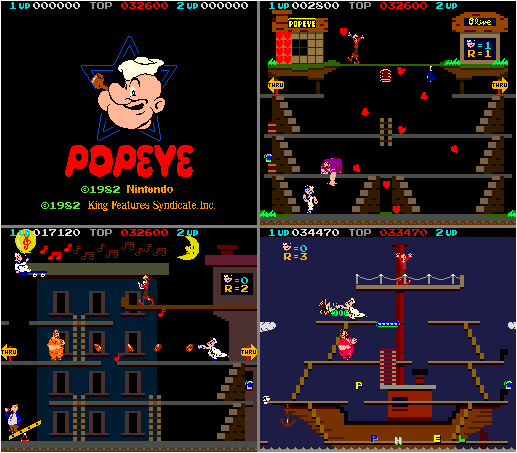GAME CLEAR No. 233 -- Popeye
video games game clear nintendo family computer pulse linePopeye (1982, Multiplatform)
Developer: Nintendo R&D1, Ikegami Tsushinki*
Publisher: Nintendo
Clear Version: Family Computer
Clear Platform: New Famicom
Clear Date: 6/10/25

| Why should I care? |
|---|
| Licensing has likely kept this Donkey Kong contemporary from receiving modern ports, but it’s just as fun as its more famous counterpart and has a superior console version to boot. |
Strong to the finish
As part of my goal to finish (or at least try) every game I bought in Japan, I’ve forged on with a Family Computer launch title, Popeye. I picked this one up mostly because it was super cheap and I have vague aspirations to own every pulse line cartridge for Famicom, but I came away pleasantly surprised at how fun it is.
The original arcade version of Popeye was released a year after Donkey Kong, but the latter was actually first conceived of as a Popeye game. Nintendo was the licensee for Popeye and had already produced playing cards and a Game & Watch title. Ultimately, Nintendo created their own new IP, of course, but a little guy rescuing a damsel in distress from a big brute obviously shows some of the Popeye DNA. This early Donkey Kong arcade flyer even shows Mario drawn in a rather Popeyesque fashion.
In an “Iwata Asks” interview, Shigeru Miyamoto fails to recall the details but says there was some sort of licensing rug-pull that prevented them from using Popeye for the 1981 arcade game. This, of course, led to the creation of the most famous video game character in the world. It sort of boggles the mind to think that a little legal snag like this could have been the cause of such a thing! Truly so many monumental events and creations are the result of insane happenstance.
Anyway, that apparently got resolved, so they moved forward with a new idea for a Popeye game not long after. Like Donkey Kong and Donkey Kong Jr., it involves a lot of walking and climbing, but instead of jumping, the muscle-bound mariner’s only other move is to punch things. Also, instead of climbing to specific destination, Popeye navigates each stage avoiding rival Bluto and collecting objects thrown by Olive Oyl.

Conveniently, Wikipedia has provided the above image to save me a lot of descriptive work. As you can see, Popeye must run around each of these rather bizarre structures to accomplish his goals. In stage 1 (top right), he must collect hearts (blown kisses?) being rained down by Olive above. In stage 2 (bottom left), Olive instead plays a harp and Popeye must collect the notes. On the final stage, Popeye must collect the letters H-E-L-P. It’s a bit of a contrivance, but it works. The collectibles take meandering paths from the top to the bottom of the screen and push you to reach them carefully but quickly, awarding more points the higher on the screen you collect them.
Bluto is a constant threat and kills Popeye if he manages to touch him or hits him with the bottles he throws. Popeye can punch the bottles to break them, but his only recourse to deal with Bluto directly is to collect the spinach that moves around each stage. Like Pac-Man with a power pellet, Popeye then must pursue the fleeing Bluto. If he catches him, he’ll send him flying into the ocean for a big points bonus. On harder difficulties, Popeye must also contend with Sea Hag, who will send bouncing skulls after him. These can also be dealt with with a simple punch, but they add to the overall chaos.
And it is a challenging Chaos. The game always has enough going on to keep you on your toes and seldom feels unfair. Unlike some of the cheaper arcade games of yesteryear, its tendencies feel generally learnable, and mistakes usually feel self-inflicted. I feel I could get significantly better at this game over time.
The fun of the game is accompanied by the typical charming sound effects and understated chiptunes of the games Nintendo was making at the time. Collecting spinach cues the classic musical theme from the Popeye cartoons, as it should.
Unlike the Famicom/NES ports of the three Donkey Kong arcade games, all of the arcade stages of Popeye made it onto the home version. That’s pretty nice since, on the other hand, the arcade version itself has not enjoyed the home releases that the Donkey Kong games have in recent years. Moreover, because the arcade original was in a normal horizontal aspect ratio, the home conversion isn’t squished like the Kong ports. Its graphics are a bit worse, yes, but it’s a far less compromised version than its counterparts.
I highly recommend this game — either the arcade original or this admirable port — to anyone that appreciates the Donkey Kong trilogy. It hasn’t had the enduring legacy that those games have, but I think it fits right in with them and is just as fun, too. We also owe a lot of video game history to the slight delay of this title, so it’s worth playing a round or two at least in honor of that.
* You can read up more on this topic on Wikipedia, but apparently the company Ikegami Tsushinki did some uncredited development work on some early Nintendo arcade titles, possibly including this one. Some mildly interesting stuff there.